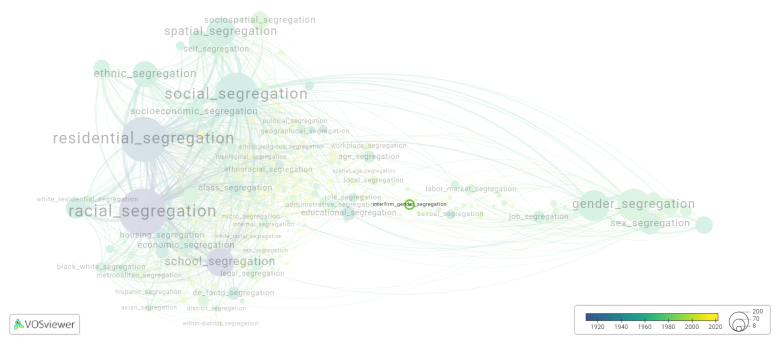Interfirm gender segregation: Difference between revisions
(Creating page) |
(Creating page) |
||
| (5 intermediate revisions by the same user not shown) | |||
| Line 17: | Line 17: | ||
Interfirm gender segregation is frequently discussed in the literature with the following segregation forms: | Interfirm gender segregation is frequently discussed in the literature with the following segregation forms: | ||
[[gender segregation]], [[occupational segregation]] | |||
[[File:interfirm_gender_segregation.png|780x780px]] | [[File:interfirm_gender_segregation.png|780x780px]] | ||
For the complete network of | |||
This visualization is based on the study [[Segregation_Wiki:About| The Multidisciplinary Landscape of Segregation Research]]. | |||
year of publication https://tinyurl.com/ | |||
For the complete network of interrelated segregation forms, please refer to: | |||
* [https://tinyurl.com/2235lkhw First year of publication] | |||
* [https://tinyurl.com/2d8wg5n3 Louvain clusters] | |||
* [https://tinyurl.com/223udk5r Betweenness centrality] | |||
* [https://tinyurl.com/244d8unz Disciplines in which segregation forms first emerged (Scopus database).] | |||
==References== | ==References== | ||
==Notes== | ==Notes== | ||
Latest revision as of 07:17, 16 October 2024
Date and country of first publication[1][edit | edit source]
1995
United States
Definition[edit | edit source]
Interfirm gender segregation refers to the phenomenon of gender segregation among different firms or companies. It can occur in various ways, including differences in the types of industries that employ primarily male or female workers, differences in the job roles and positions available to male and female employees, and differences in the workplace cultures and practices that may perpetuate gender stereotypes and create barriers for advancement.
Some industries, such as construction, engineering, and technology, have traditionally been male-dominated, while industries like healthcare, education, and social services have a higher proportion of female workers. This segregation can limit career opportunities for individuals based on their gender.
Within firms, gender segregation can also be observed in the distribution of job roles and positions. For example, certain roles, such as senior management or technical positions, may be predominantly held by men, while women tend to be overrepresented in administrative or support roles. This can result from bias and gender stereotypes that influence hiring decisions and limit the career progression of women.
Workplace cultures and practices can also contribute to gender segregation. Male-dominated environments may have norms and practices that create barriers for women to enter or advance in certain roles. This can include limited access to mentorship and sponsorship opportunities, exclusion from informal networks, and lack of flexible work arrangements to accommodate family responsibilities.
Addressing interfirm gender segregation requires proactive measures from both firms and policymakers. Companies can take steps to promote diversity and inclusion, such as implementing targeted recruitment and promotion strategies, providing equal access to training and development opportunities, and fostering an inclusive organizational culture. Policy interventions, such as enforcing equal pay legislation, promoting family-friendly policies, and creating awareness campaigns about gender stereotypes, can also contribute to reducing interfirm gender segregation.
See also[edit | edit source]
Related segregation forms[edit | edit source]
Interfirm gender segregation is frequently discussed in the literature with the following segregation forms:
gender segregation, occupational segregation

This visualization is based on the study The Multidisciplinary Landscape of Segregation Research.
For the complete network of interrelated segregation forms, please refer to:
References[edit | edit source]
Notes[edit | edit source]
- ↑ Date and country of first publication as informed by the Scopus database (December 2023).
At its current state, this definition has been generated by a Large Language Model (LLM) so far without review by an independent researcher or a member of the curating team of segregation experts that keep the Segregation Wiki online. While we strive for accuracy, we cannot guarantee its reliability, completeness and timeliness. Please use this content with caution and verify information as needed. Also, feel free to improve on the definition as you see fit, including the use of references and other informational resources. We value your input in enhancing the quality and accuracy of the definitions of segregation forms collectively offered in the Segregation Wiki ©.
Interfirm gender segregation appears in the following literature[edit | edit source]
Carrington W.J., Troske K.R. (1995). Gender segregation in small firms. Journal of Human Resources, 30(3), 503-533. https://doi.org/10.2307/146033
